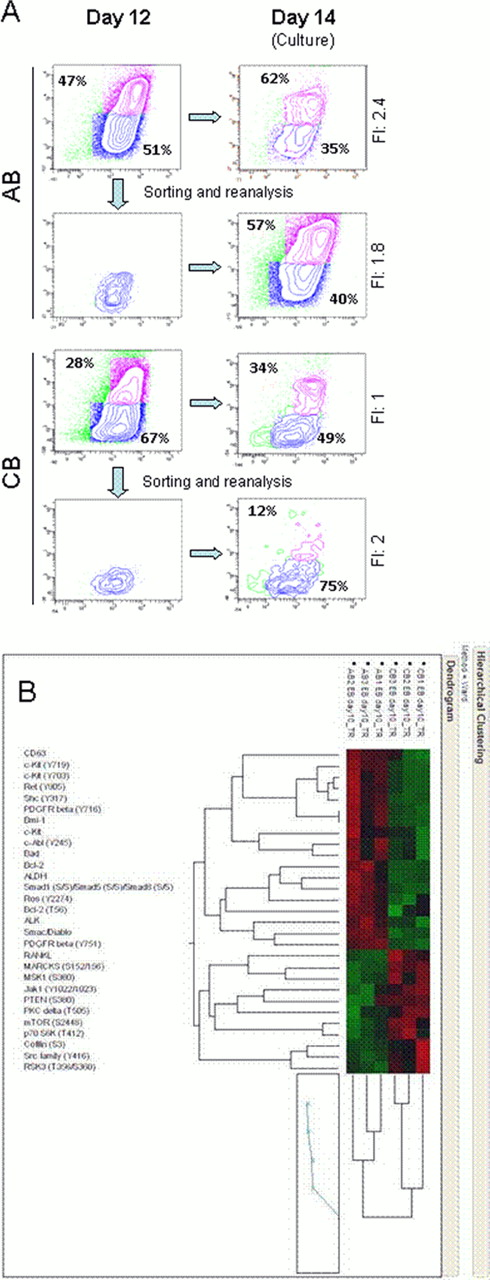Abstract
Abstract 2339
In mice, loss-of-function studies have identified that glucocorticoid receptor (GR) activation mediates the massive red blood cell expansion occurring following stress challenges. This effect involves generation of stress-specific erythroid precursors expressing KIT (the receptor for SCF), CD71 (the transferrin receptor co-expressed in human erythroblasts with CD36) and TER119 (Glycophorin A) that are blocked in maturation and induced into a self-replication state.
Studies in culture indicate that GR activation increases also the generation of human erythroid cells. In fact, human CD34poscells from adult (AB) or cord (CB) blood give rise to great numbers of erythroblasts within 14–18 days when cultured with SCF, IL-3, EPO and the GR agonist dexamethasone (DXM) (fold increase: 691±257 vs 396±187 from AB or CB). Whether the effects of GR on human erythropoiesis are mediated by stress-specific erythroid precursors phenotypically and functionally similar to those observed in mice remains to be demonstrated.
In this study, the phenotype and properties (proliferation potential and proteomic profile) of erythroid precursors present at day 10 in cultures of AB- and CB-derived CD34poscells in the presence of DXM were compared. The phosphoproteomic profile was evaluated by Reverse-phase Protein MicroArray (RPMA) technology, using a broad library of 170 antibodies against signaling proteins representative of the main pathways controlling proliferation, survival, migration and adhesion using appropriate cell lines as array calibrators.
By day 10, AB- and CB-derived cultures contained equal numbers (50–70%) of erythroid precursors with the phenotype CD34neg/CD117pos/CD36pos/CD235alow similar to that expressed by murine stress-specific erythroid precursors. AB-derived precursors expressed two-times more CD117 than the CB-derived ones [MFI=1,200 vs 722] and could be sequentially purified and re-cultured every two-days for at least three times generating both additional CD34neg/CD117pos/CD36pos/CD235alow precursors and mature erythroblasts (CD235apos). By contrast, CB-derived precursors generated additional precursors and mature erythroblasts for only one passage generating only erythroid precursors from the second passage on (Fig. 1A).
Unsupervised hierarchical clustering and non-parametric statistical analysis comparing the activation status of a first set of 120 signaling proteins in day 10 erythroid precursors from 3 CB and 3 AB was performed. The phospho-proteomic profile of cells derived from the 3 AB was remarkably similar, as was that of cells derived from the 3 CB. Among those 120 proteins, 25 proteins were differently activated (p=0.049) in dexamethasone treated precursors derived from AB or CB. AB-derived cells expressed activated levels of KIT (both in terms of amount and of levels of phosphorylation at tyrosine Y719 and Y703), PDGFR beta and Bcl-2 while CB-derived erythroid precursors expressed activated levels of mTOR, p70S6K, Src and PKC delta among others, and increased expression of RANKL.
In conclusion, these data indicate that DXM sustains massive erythroid expansion of both CB- and AB-derived erythroblasts by inducing the generation of erythroid precursors similar in phenotype to the stress-specific erythroid precursors identified in mice. However, the biological properties of the erythroid precursors derived from AB and CB are different. The self-renewal state of AB-derived precursors does not impairs maturation potential and is probably driven by receptor tyrosine kinases (KIT and PDGFR) while the self-renewal potential of the CB-derived precusors is associated with loss of maturation potential which may occur through a cytoplasmic signaling network activation involving mTOR and Src.
No relevant conflicts of interest to declare.
Author notes
Asterisk with author names denotes non-ASH members.


This feature is available to Subscribers Only
Sign In or Create an Account Close Modal